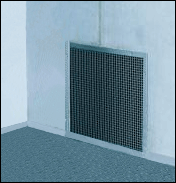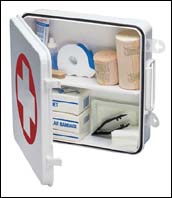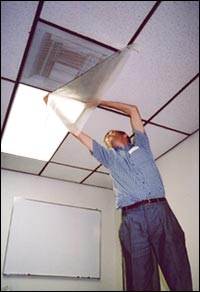| Shelter-in-Place |
| |
Chemical, biological, or radiological contaminants may
be released into the environment in such quantity and/or
proximity to a place of business that it is safer to remain
indoors rather than to evacuate employees. Such releases
may be either accidental or intentional. Examples of situations
that might result in a decision by an employer to institute
"shelter-in-place" include an explosion in an
ammonia refrigeration facility across the street, or a
derailed and leaking tank car of chlorine on the rail
line behind your place of business.
"Shelter-in-place"
means selecting an interior room or rooms within your
facility, or ones with no or few windows, and taking refuge
there. In many cases, local authorities will issue advice
to shelter-in-place via TV or radio.
Related information:
|
|

|
| Preparing
to stay or go |
Depending
on your circumstances and the type of emergency,
the first important decision is whether you stay
put or get away. You should understand and plan
for both possibilities. Use common sense and available
information, including what you are learning here,
to determine if there is immediate danger. In
any emergency, local authorities may or may not
immediately be able to provide information on
what is happening and what you should do. Use
available information to assess the situation.
If you see large amounts of debris in the air,
or if local authorities say the air is badly contaminated,
you may want to "shelter-in-place."
However, you should watch TV, listen to the radio,
or check the Internet often for information or
official instructions as it becomes available.
If you are specifically told to evacuate
or seek medical treatment, do so immediately.
|
|

Use telephones, televisions,
and radios for receiving instructions or emergency information.

The Internet may be a valuable source
of information during an emergency.
|
If you intend to include a shelter-in-place
option in your emergency plan, be sure to keep the following
in mind:
 |
- Implement a means of alerting
your employees to shelter-in-place that
is easily distinguishable from that used to
signal an evacuation.
- Train employees in the shelter-in-place
procedures and their roles in implementing
them.

Train employees for
shelter-in-place
procedures just the same as you would
for evacuation procedures.
|
Alarm methods may vary
depending
on the type of emergency
|
|
| Shelter-in-place
procedures |
Specific procedures for shelter-in-place
at a worksite may include the following:
- If there are customers, clients, or visitors in
the building, provide for their safety by asking them
to stay – not leave. When authorities provide
directions to shelter-in-place, they want everyone
to take those steps immediately. Do not drive or walk
outdoors.
- Unless there is an imminent threat, ask employees,
customers, clients, and visitors to call their
emergency contact to let them know where they
are and that they are safe.
- Turn on call-forwarding or alternative telephone
answering systems or services. If the business
has voice mail or an automated attendant, change
the recording to indicate that the business
is closed, and that staff and visitors are remaining
in the building until authorities advise it
is safe to leave.
|
|

Have employees and anyone
else in the building call their emergency contacts, then
turn on answering
systems.
|
- Quickly lock exterior doors and close windows,
air vents, and fireplace dampers. Have employees
familiar with your building’s mechanical
systems turn off all fans, heating and air conditioning
systems, and clothes dryers. Some systems automatically
provide for exchange of inside air with outside
air. These systems, in particular, need to be
turned off, sealed, or disabled.
- If you are told there is danger of explosion,
close the window shades, blinds, or curtains.
|
|

Close or tape-off
all vents in the room.
|
| |

Gather essential supplies
such as a first-aid kit. |
- Gather essential disaster supplies, such as
nonperishable food, bottled water, battery-powered
radios, first-aid supplies, flashlights, batteries,
duct tape, plastic sheeting, and plastic garbage
bags.
- Select interior room(s) above the ground floor,
with the fewest windows or vents. The room(s)
should have adequate space for everyone to be
able to sit. Avoid overcrowding by selecting
several rooms if necessary. Large storage closets,
utility rooms, pantries, copy and conference
rooms without exterior windows will work well.
Avoid selecting a room with mechanical equipment
like ventilation blowers or pipes, because this
equipment may not be able to be sealed from
the outdoors.
|
- It is ideal to have a hard-wired telephone in the
room(s) you select. Call emergency contacts and have
the phone available if you need to report a life-threatening
condition. Cellular telephone equipment may be overwhelmed
or damaged during an emergency.
- Take your emergency supplies and go into the
room you have designated. Seal all windows,
doors, and vents with plastic sheeting and duct
tape or anything else you have on hand.
- Consider precutting plastic sheeting (heavier
than food wrap) to seal windows, doors, and
air vents. Each piece should be several inches
larger than the space you want to cover so that
it lies flat against the wall. Label each piece
with the location of where it fits. [See Figure
1]
- Write down the names of everyone in the room,
and call your business’ designated emergency
contact to report who is in the room with you,
and their affiliation with your business (employee,
visitor, client, customer).
- Listen to the radio, watch television, or
use the Internet for further instructions until
you are told all is safe or to evacuate. Local
officials may call for evacuation in specific
areas at greatest risk in your community.
|
|

Figure 1. Tape plastic sheeting
over
vents, windows, and doors to
prevent contaminated air
from entering the room.
|
|
| Links
to additional information |
The following websites provide
additional information on Shelter-In-Place:
- Chemical
Stockpile Emergency Preparedness Program (CSEPP). Federal Emergency Management
Agency (FEMA). Describes the Chemical Stockpile
Emergency Preparedness Program (CSEPP) as a unique
partnership between FEMA and the U.S. Army, given
FEMA's long-standing experience in preparing for and
dealing with all types of emergencies and the U.S.
Army's role as custodian of the U.S. chemical
stockpile. Since 1988, FEMA and the U.S. Army have
assisted communities surrounding the eight chemical
stockpile sites to enhance their abilities to respond
to the unlikely event of a chemical agent emergency.
- Planning Protective Action Decision Making:
Evacuate or Shelter in Place? Oak Ridge National
Laboratory (ORNL), (2002, June), 108 KB
PDF, 40 pages. Evaluates the decision of whether
to evacuate or shelter-in-place.
A successful evacuation removes people from the
affected area and avoids exposing them to a harmful
concentration of the toxic chemical. An inappropriate
decision to evacuate, on the other
hand, can have negative consequences if it results in
the population of the affected area
being caught outdoors or in their vehicles when
contamination enters the area.
Sheltering can be worse than evacuation if shelters
are
leaky, people are not told when to
come out of the shelter, or the release continues for
a
long time.
-
Make a Plan
- Deciding to Stay or Go. Ready.gov (U.S.
Department of Homeland Security), (2003).
Identifies the first important decision after an
incident occurs is whether to shelter-in-place or
evacuate. Advises that local authorities may or may
not immediately be able to provide information on what
is happening and what you should do. However, you
should monitor TV or radio news reports for
information or official instructions as they
become available.
-
Design Guidance for Shelters and Safe Rooms.
Federal Emergency Management Agency (FEMA) Publication
453, (2006, May). Also available as a 12 MB
PDF, 264 pages. Covers a range of protective
options, from low-cost expedient protection (what is
commonly referred to as sheltering-in-place) to safe
rooms ventilated and pressurized with air purified by
ultra-high-efficiency filters. These safe rooms
protect against toxic gases, vapors, and aerosols
(finely
divided solid or liquid particles).
- Shelter-in-Place
in an Emergency. American Red Cross, (2003). Shelter-in-place means selecting a small,
interior room, with no or few windows, and taking
refuge there. It does not mean sealing off your entire
home or office building. Instructions are provided in
this fact sheet.
|
Accessibility Assistance: Contact the OSHA Directorate of Science, Technology
and Medicine at 202-693-2300 for assistance accessing PDF materials.
|

